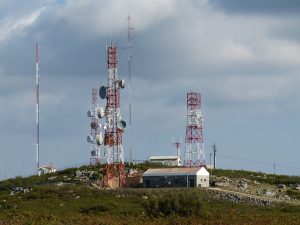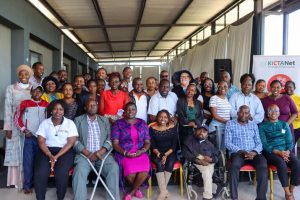Twahir
This might be of interest to you.
Rgds.
From: [email protected] <[email protected]> on behalf of [email protected] <[email protected]>
Sent: Thursday, November 8, 2018 7:55 PM
To: DC NN; [email protected]
Subject: [global-nn] DC3 Community Network Manual published by FGV, ITU and ISOC
Dear colleagues, (apologies for cross-posting)
It is a pleasure to announce the release of “The Community Network Manual: How to Build the Internet Yourself”, which is published in partnership by FGV<portal.fgv.br/en>, ITU<www.itu.int/en/Pages/default.aspx> and ISOC<www.internetsociety.org/> and is the 2018 outcome of the IGF Dynamic Coalition on Community Connectivity (DC3)
The Community Network Manual features a series of analyses providing guidance on how to build Community Networks and how to make them scalable, sustainable and law-compliant. The volume will be launched at the IGF, on Monday 12 November, at 11:20, during the DC3 Session: When the Unconnected Build Connectivity<www.intgovforum.org/multilingual/content/igf-2018-dc-community-connectivity-when-the-unconnected-build-connectivity-dc3>
Community Networks are crowdsourced networks structured to be open, unrestricted, and to respect net neutrality. They rely on the active participation of local communities in the design, development, deployment, and management of shared infrastructure as a common resource. They are managed democratically by group of individuals and entities such as NGOs, local businesses, and/or public administrations.
This is the third volume of a trilogy. Previous DC3 reports were dedicated, in 2017, to “Community networks: the Internet by the people, for the people<communityconnectivity.xyz/>” and, in 2016, to “Community Connectivity: Building the Internet from Scratch<bit.ly/2gZB2kn>”. All volumes are freely available, under Creative Commons License.
Below you will find the table of content as well as the early praise by Bruno Ramos (ITU) and Andrew Sullivan (ISOC)
Feel free to share this email through your networks
Best regards
Luca
“Community networks represent a valuable alternative model that deserves to be explored to improve access to Information and Communication Technologies to underserved communities worldwide. ITU is committed to connecting the entire world’s people and this book and the work of the UN IGF Dynamic Coalition on Community Connectivity offer inspiring and transparent guidance to foster digital inclusion.”
Bruno Ramos, Director for the Americas Regional Office of the International Telecommunication Union
“Community Networks offer a credible solution for building a digital future that puts people first. This volume is a testament to the excellent work of the IGF Dynamic Coalition on Community Connectivity. It is a long-awaited guide that will allow many to participate in the Internet’s evolution, building an Internet for everyone..”
Andrew Sullivan President and Chief Executive Officer of the Internet Society
CONTENT
PREFACE by Bruno Ramos……………………………………………………………………………………………………………….. 9
ABOUT THE AUTHORS……………………………………………………………………………………………………………………….. 13
1 Community Networks: Bridging Digital Divides through the Enjoyment of Network Self-determination……………………………………………… 23
Luca Belli
PART I: How to Build your Community Network…………………………………………………………… 41
2 Building Community Wireless Networks: A How-to Guide for the Curious……………………………………………………………………………………………………………….. 43
Steven Mansour and Sascha Meinrath
3 Building Community LTE Networks with CoLTE………………………………… 75
Spencer Sevilla, Pathirat Kosakanchit, Matthew Johnson and Kurtis Heimerl
4 The MAZI Toolkit for Do-It-Yourself Networking………………………………… 103
Harris Niavis, Stavroula Maglavera, Aris Dadoukis and John Mavridis
5 LibreRouter: the Hardware and Software Platform for
Community Networking………………………………………………………………………………………….. 119
Nicolas Echániz and Florencia López Pezé
PART II: Scalable, Sustainable and Law-compliant Community Networks………. 131
6 Multiple Dimensions of Community Network Scalability………………. 133
Roger Baig Viñas, Leandro Navarro and Ramon Roca i Tió
7 Federating Community Networks:
A Case-study from France……………………………………………………………………………………. 159
Félix Tréguer
8 Fostering Sustainability of Community Networks:
Guidelines to Respect the European Legal Framework………………… 177
Virginie Aubrée and Mélanie Dulong de Rosnay
9 Complementary Networks Meet Complementary Currencies:
Guifi.net Meets Sardex.net ………………………………………………………………………………….. 189
Panayotis Antoniadis, Jens Martignoni, Leandro Navarro and Paolo Dini
10 What Could Blockchain do for Community Networks……………………. 223
Panayotis Antoniadis and Jens Martignoni
11 DECLARATION ON COMMUNITY CONNECTIVITY……………………………………………….. 248
————————————————————————————————————
Luca Belli, PhD
Professor of Internet Governance and Regulation, FGV Rio de Janeiro Law School
Chercheur Associé, Centre de Droit Public Comparé, Université Paris 2
www.internet-governance.fgv.br
@1lucabelli
————————————————————————————————————
———————————————————————————-
Grace Githaiga
Twitter: @ggithaiga
Skype: gracegithaiga
Linkedin: www.linkedin.com/in/gracegithaiga
…the most important office in a democracy is the citizen. So, you see, that’s what our democracy demands. It needs you!—-Barrack Obama.
________________________________
From: kictanet <[email protected]> on behalf of Twahir Hussein Kassim via kictanet <[email protected]>
Sent: Thursday, November 8, 2018 4:38 PM
To: [email protected]
Cc: Twahir Hussein Kassim; Otieno Antony; [email protected]; KICTAnet ICT Policy Discussions
Subject: Re: [kictanet] Community Networks
Thanks Josephine for that info. If I may ask, TUNAPANDA (assuming you’re still there) operarates on what kind of license?
Listers thanks for the interest in this project, am now more confident that this will happen (God willing). Will sure send an invite to the whole group for the launch 🙂
On Thu, Nov 8, 2018, 19:20 Josephine Miliza <[email protected]<mailto:[email protected]>> wrote:
Hi Twahir,
Great to hear that you want to start this in Kilifi! Currently, community networks are not recognized under the CA regulatory framework. Using unlicensed spectrum is one way to start, but this also requires an operating license from CA.
I would not say CA is silent on this, the community network movement in Africa is quite young, although we have networks for example in Zambia, Uganda, and South Africa that have existed for over 5 years. In those countries, all have operating licenses. At this point, what is needed is more awareness on the role that community networks play in connecting communities that may not make a good market case for traditional ISPs/telcos, also on the impact beyond access such as digital literacy training and catalyzing the local economies.
On Thu, Nov 8, 2018 at 7:02 PM Twahir Hussein Kassim via kictanet <[email protected]<mailto:[email protected]>> wrote:
YES! Thanks Wainaina, that’s cool! Definitely need partners on the project!
On Thu, Nov 8, 2018, 18:33 Wainaina Mungai <[email protected]<mailto:[email protected]>> wrote:
Hi Twahir,
ISOC Kenya would be more than happy to explore a partnership as part our support for Community Networks.
Please reach me on [email protected]<mailto:[email protected]>
Karibu,
Eng. Wainaina Mungai
President & Chairman
INTERNET SOCIETY KENYA CHAPTER
4th Floor, Wing C, NaiLab, Bishop Magua Centre
George Padmore Lane, Off Ngong Road,
Nairobi, Kenya
Skype: wainaina.mungai
Tel: + 254 722 811171
Email: [email protected]<mailto:[email protected]>
URL: www.isoc.or.ke<www.isoc.or.ke>
Twitter: @ISOC_KENYA
Facebook: @ISOCKenyaChapter
On 8 Nov 2018 18:15, Twahir Hussein Kassim via kictanet <[email protected]<mailto:[email protected]>> wrote:
Thanks John, you really have given me a morale boost!
On Thu, Nov 8, 2018, 18:01 John Gitau <[email protected]<mailto:[email protected]>> wrote:
You dont need much, an operating license, if you will ride on an existing ISP, you wont need an ISP license, depending on services you might need a CSP and or ASP license. Microwave/wimax is subject to frequency approvals and is costlier but as someone mentioned i’d just work with 2.4/5GHz. maybe a telecommunication personnel license
There is a whole host of things you can do but if planning to start small nothing stops you from being online next week within three months at worst:-)
JG
On Thu, Nov 8, 2018 at 5:54 PM Twahir Hussein Kassim via kictanet <[email protected]<mailto:[email protected]>> wrote:
Barrack,
Thanks bro, you are a God sent blessing. Will reach out to them.
THK
On Thu, Nov 8, 2018, 17:12 Barrack Otieno <[email protected]<mailto:[email protected]>> wrote:
Hi Twahir,
You may want to consult Michuki Mwangi from ISOC or Josephine Miliza
from TunapandaNet in Kibera who are experts on the subject. I think
some guidance from CA on the matter will also be usefull, our good
friend Mr. Wambua is always at hand to clarify such issues.
Best Regards
On 11/8/18, Twahir Hussein Kassim <[email protected]<mailto:[email protected]>> wrote:
> Barrack,
>
> I intend to get a fibre / microwave link to a central point and from there
> have point to points to the various villages and schools in the area.
>
> On Thu, Nov 8, 2018 at 4:53 PM Barrack Otieno <[email protected]<mailto:[email protected]>>
> wrote:
>
>> Hi Twahir,
>>
>> Which range of Spectrum do you intend to use? That might determine
>> whether you need a license from CA.
>>
>> Regards
>>
>> On 11/8/18, Twahir Hussein Kassim via kictanet
>> <[email protected]<mailto:[email protected]>> wrote:
>> > Listers,
>> >
>> > Am looking at rolling out a community network in Kilifi. What are the
>> > government regulations on this? CA website is silent on this.
>> >
>> > Regards,
>> > Twahir
>> >
>>
>>
>> —
>> Barrack O. Otieno
>> +254721325277
>> +254733206359
>> Skype: barrack.otieno
>> PGP ID: 0x2611D86A
>>
>



